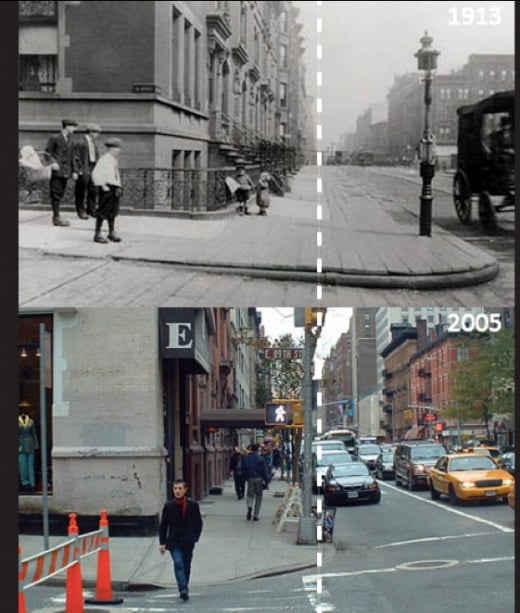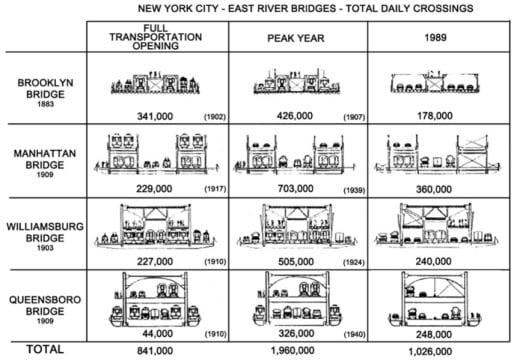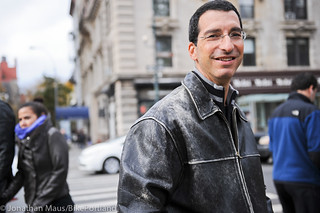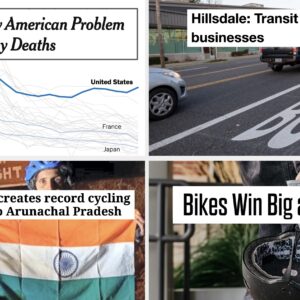
(Photos © J. Maus/BikePortland)
Livable streets activist and financier Mark Gorton is tired of business as usual when it comes to transportation reform. Simply put, he feels the way American cities design their streets with cars as a top priority is “insane” and that settling for incremental change is not acceptable given the dramatic — and negative — impacts car overuse has on our lives.
made possible by:
- Planet Bike
- Lancaster Engineering
- Readers like you!
Spurred by success in New York City, he’s now setting sights on main streets across the country. His new effort is tentatively named the American Streets Renaissance and he’s traveling the country encouraging advocates and anyone who will listen that it’s time to “Re-think the automobile.”
So who is this guy and why should you care?
Gorton and the community of activism he’s funded and fostered, have played key roles in the proliferation of protected bike lanes and public plazas throughout New York City, a place where — as I found out myself last week — innovative street design is all but institutionalized. Now Gorton wants to expand his influence beyond the Big Apple; and given his track record, I wouldn’t bet against him.
If you haven’t heard about Mark Gorton, you’re excused. He’s been far from front-and-center in the bike and transportation advocacy world. He made his name (and his fortune) as the software whiz behind the Limewire music sharing service (which earned him a copyright lawsuit which he settled for $105 million last year) and now owns a suite of companies powered by software he’s helped develop. When it comes to livable streets activism, his most important investment has been the New York City Streets Renaissance (NYCSR) campaign. In 2005, just as blogging was taking hold as a legitimate source of news, Gorton-backed Streetsblog (which launched in New York City in 2005 and has since spawned Streetfilms and blog editions in Los Angeles, San Francisco and DC). Gorton has also been a major funder of Transportation Alternatives, New York City’s largest active transportation non-profit.
Gorton has a rare mix of Ivy League intelligence, an activist’s passion, entrepreneurial acumen, and most importantly, the ability to put his money where his mouth is.
I had planned to meet Gorton on the Upper West Side of Manhattan for an interview on Monday, October 29th; but with Sandy quickly approaching and evacuations being ordered, we decided a phone interview would be more prudent (I did end up meeting Gorton a few days later in person to get photographs).
Even on the phone, it didn’t take Gorton long to get fired up. “We have to stop this insanity,” he said, in a refreshingly direct way.
When Gorton and the community of activists he supported went to work back in 2003, they faced a very tall order. “[Mayor] Bloomberg was saying things like, ‘We like traffic, it’s a sign of economic progress’,” he recalled, “It was like, ‘There’s a lot of traffic, what are you going to do about it? It’s always been that way.'” To the policymakers at City Hall and DOT, questioning that status quo of streets where cars, trucks and taxis reigned supreme, Gorton said, “Was like saying New York shouldn’t have tall buildings.”
“The fact is, people are dying, people’s lives are being shortened… Now it’s time for planners and officials to start owning the health and safety of citizens. It’s about not letting these people get away with it anymore.”
When Gorton first got involved with Transportation Alternatives, they only had three employees (they now have over 30), but they were winning enough issues — like access to East River bridges and the West Side Greenway — that Gorton said he was inspired to join up and help them out. “The strategy back then was incremental change on the margins, with the assumption that the world would always be dominated by cars… Even Transportation Alternatives is a self-marginalizing name…. The mindset was, ‘Just let us have something. Please?!'”
With the NYSCR campaign, the goal was two-fold. First, Gorton said they needed to illustrate the problem, and then they had to offer solutions. “If you think the status quo is right, it’s pretty hard to change, so step one was getting people to understand that the status quo was not right, that there were better ways to do things, and that things have been stupid for long enough.”
To get things rolling, Gorton and his team developed a package of messages, held several high-profile events, and got well-known Manhattanites to host an exhibition of livable streets designs. “We were raising consciousness, rallying the troops, getting people excited,” he recalled. Once Streetsblog was humming along, it became a “beacon” Gorton said. “A lot of people knew cars were oppressive and that traffic wasn’t safe, but you felt like a freak at Community Board meetings for saying so. Streetsblog said, ‘You’re not alone, here are the resources you need to do something about it.’ People got activated.”
A few years later, Streetsblog and Gorton’s Street Renaissance campaign had educated and activated a significant number of New Yorkers. Suddenly, livable streets had found a strong voice in the local transportation dialogue (and that’s saying a lot in such a major city like New York).
Gorton fondly recalled how the tone changed at some of those Community Board meetings when heated transportation issues would arise. “You should have heard how articulate people in the community were… You could just tell how empowered people are with this message. It’s been a real force in the city.”
Many people lay all the credit for New York’s sweeping street transformations on NYC DOT Commissioner Janette Sadik-Khan and Mayor Bloomberg. Gorton feels they’ve been fortunate to have that pair in power, but adds, “We created the political environment were it was possible for them to do all that stuff.” (Note: Gorton’s efforts stand on the shoulders of years of important work by activists like Times Up! and others that also laid crucial groundwork for change.)
Key to their success, Gorton says, was not being afraid to, “shock the sensibilities.” As if speaking to a group of old-school, highway-centric, transportation power brokers, Gorton exclaimed, “You’re ruining our country! You’re wasting our money! You should stop being so cavalier about it.”
City transportation officials (and even some professional bike advocates) live in fear of being perceived as too “anti-car.” Even Janette Sadik-Khan, he says, is “holding back” out of fear of a backlash. But Gorton pulls no punches when it comes to framing the narrative about car overuse. “They’re a plague on the city,” he says matter-of-factly. During his keynote speech at the recent Pro Walk/Pro Bike conference, Gorton raised eyebrows when he said there should be a nationwide moratorium on expanding and/or building highways. (Even in progressive Portland, both Metro and the City of Portland have recently green-lighted major highway expansion projects.)
Gorton says after his speech at Pro Walk/Pro Bike, a bike advocate came up to him to say they enjoyed his talk, but that saying we shouldn’t build any more highways is just over the top. “Afterwards, I was thinking, why can’t I say that? Why, as a bike advocate do you feel like you have to lie on behalf of the auto industry? I think we’ve just been conditioned for so long that now it’s somehow crazy to suggest things like this.”
So you’re not you worried about people dismissing you as too radical? Too crazy? I asked him. “This is not crazy!” he replied, “Everyone else is crazy; endangering the lives of your children every day is crazy.”
“The fact is, people are dying, people’s lives are being shortened,” he continued, “Why aren’t people impatient? Why aren’t they holding people accountable? Now it’s time for planners and officials to start owning the health and safety of citizens. It’s about not letting these people get away with it anymore.”
If you write off Gorton as just an anti-car firebrand, you’d be missing the complete picture. He feels that cars are an important and necessary invention, but they’re simply better suited to the countryside. “The automobile is a rural technology that has been misapplied to cities,” reads a slide in one of the presentations he’s been giving throughout the country. “They are a spatially inappropriate technology for a dense city.”
To back up his rhetoric, Gorton has some very compelling stats. For instance, today, 370,000 fewer people enter New York City’s central business district each weekday than in 1948; but there are now 450,000 more cars entering the CBD than in 1948. These numbers form the basis of one of Gorton’s key arguments; that the shift to the private automobile has destroyed transportation capacity. He shares this graphic to back it up (click to enlarge):
While he has a bevvy of stats and figures to make his case, Gorton’s primary argument is that the overuse of cars has dramatically curtailed the ability for human life to flourish in cities. Sidewalks, plazas, and parks — which used to be the hallmark of great cities (including New York) — have been chipped away at in order to make more space to move more automobiles at ever-increasing speeds. (And, contrary to popular myth, Gorton says more cars in a city is not tied to increased economic growth.)

In order to reverse this trend and reclaim urban space, Gorton is calling for a “total transformation” of urban streets. His presentations outline solutions like timed street closings (like Sunday Parkways), parking reform, congestion pricing, better transit, complete bicycle networks, and more. He also says advocates need to “step up their game” in order to push for these changes. “This is part of the whole point of a renaissance. To go bigger than before, to stop being patient with the stupidity. People need to be a little fed up with this acceptance of this status quo.”
“What gets me worked up is that my kids can’t go anywhere to play alone, that our streets have crushed their independence… That we’ve destroyed our human living environment.”
Gorton looks at the lack of progress on the national level as one reason he thinks a new approach is needed (the only silver lining to MAP-21, national bike organizations said, was that it could have been much worse). “There’s a lot of people that have been working on federal transportation reform for a while… and it hasn’t been going really well. If you look at the national policy, it’s just backwards. I think there’s a lot of receptiveness to coming up with a new strategy now. A lot of people look at this new bill and say, this is unacceptable.”
To get things moving in the right direction, Gorton will focus on messaging. He’s a believer that the way we talk about transportation issues matters. “I don’t like to talk about ‘global warming’ or ‘sustainability’. Those terms are so nebulous. That’s not what gets me worked up,” he said. “What gets me worked up is that my kids can’t go anywhere to play alone, that our streets have crushed their independence… That we’ve destroyed our human living environment.”
To Gorton, the battle being waged in cities is far from a “war on cars.” In fact, he’d rather not use the term “war” because he feels there area lot of people who aren’t comfortable with that type of rhetoric. “But,” he’s quick to add, “the fact is there’s a war on people, on childhood mobility… And the auto industry is winning that war. If you you want to talk death, victims, casualties, you have to look at who’s the aggressor. I don’t have a problem using strong language when it comes to the safety of our neighborhoods.”
In addition to human terms, Gorton says the key to moving the needle is to talk about transportation reform in fiscal terms. “If you want to win over Tea Party Republicans — or even mayor and governors trying to balance budgets — highway infrastructure is a 20-cent on the dollar return, that’s just a waste of money. That’s how you bankrupt the country. In a world where money isn’t flowing like it used to, you have to cut back.”
Changes to increase capacity on our roadways and make them more accessible to biking don’t have to come with big, expensive capital projects. “A lot of this stuff could be simply policy changes,” he says. “On the Upper West Side, for example, you could say there’s no parking on every side street on weekends and there’s no through traffic. You could implement that within two weeks.”
What about suburbs and outlying neighborhoods? Do they get to enjoy the fruits of this street renaissance? Gorton, who grew up in the suburbs, said he’s working on that issue. He said cars would still have a role in the suburban context, but that large roads offer a lot of room for things like bike boulevards. Another thing he’d push for in suburbs are changes to zoning rules.
In the end, Gorton believes the time is now for a stronger transportation reform movement. “People are ready for this,” he repeated during our conversation. Even if all the large, mainstream advocacy groups feel his style is too radical, Gorton believes there’s still a strong enough movement out there that he’ll be able to succeed.
It comes to a sense of urgency to shift the status quo; but it doesn’t have to mean a gloves-off approach. “I’m happy to engage people,” said Gorton, “but I’m getting less and less tolerant of accepting their mistakes. They’re hurting our country. It’s not O.K.”
“I don’t want to wait for my kids to grow up to make these changes.”
—
Learn more about Gorton and download his presentations at RethinkTheAuto.org.









Thanks for reading.
BikePortland has served this community with independent community journalism since 2005. We rely on subscriptions from readers like you to survive. Your financial support is vital in keeping this valuable resource alive and well.
Please subscribe today to strengthen and expand our work.
Masterful!
Thanks for the inspiration, Jonathan.
“You should have heard how articulate people in the community were…”
And that I think is just as true here, and probably everywhere. Good to know that people with passion and deep pockets noticed this too.
I agree wholeheartedly with Gorton’s common sense, ‘big tent’ approach to messaging. Framing the discourse in terms that everyone can agree upon- your money, your time and your health is brilliant.
You could make a slide for Hawthorne Blvd. exactly like that 1913/2005 comparison slide; the sidewalks in the CBD on Hawthorne were significantly narrowed at some point in the mid-20th century to add one extra motor vehicle lane in each direction.
I’ve been showing videos of Mark Gorton ranting about how harmful cars are to urban communities for years. If only we had a voice as strong as his here in passive-passive Portland, somebody to call bulls**t on the BTA for having such limp-wristed responses when the Portland Business Alliance makes decisions about bike lanes for PBOT.
Great post, Jonathan. I’ve been following Streetblogs and Streetfilms for a while…
“To stop being patient with the stupidity. People need to be a little fed up with this acceptance of this status quo.”
Amen, bro. The deep assumptions have to start changing, and the only way that happens is when enough people really start resisting.
50 years ago everyone smoked and if you didn’t you were dismissed as a “health nut.” When people can see the problem and push back, then things change. The basic assumptions, what is transparent and what is not, change.
I could mention the civil rights movement and era as well. It would not be hyperbole. As Gorton points out, an enormous amount is involved here–people’s lives, their health and yes, their dignity and all on a mass scale. A real urban revolution of the kind he argues for would be as consequential as the civil rights movement and what it accomplished.
I want to marry this guy. And not just for his money, I swear!
The bridge timeline is pretty damning of our current approach to widening roadways for added auto capacity.
I love love love Streetfilms! You can pick any video on their website and be amazed. High quality work every time. Wish we could get a Portland satellite office.
Mark is one of my personal heroes.
He has more than enough money that the guy could have said, “screw this nonsense – I’m rich, I’m moving to Amsterdam” and had a great life enjoying livable streets and most the ideals he wants for our own cities.
Instead, he takes a courageous stand, putting his brain, money, and a willingness to voice truths that are correct but culturally out-of-whack, just as my mom was seen odd when she told people not to smoke in her house in the 1960s.
To me, it was reading streetsblog every day that led me to realize how many other people who care about this stuff exist, and that we are winning in other cities. It was seeing Transportation Alternatives kick ass for cycle-tracks and 8-80 bike facilities in 2009-2011 that inspired me to kick in a four-figure donation to be part of that success, since we weren’t seeing any of it in Seattle quite yet.
I don’t listen to the MP3s I pirated off LimeWire anymore (and hey, I’m a music publisher myself so don’t give me any cr*p), but Mark has definitely made a lasting impression on my life.
Please visit us in Seattle! 😉
“…He feels that cars are an important and necessary invention, but they’re simply better suited to the countryside. “The automobile is a rural technology that has been misapplied to cities,” reads a slide in one of the presentations he’s been giving throughout the country. “They are a spatially inappropriate technology for a dense city.” …” maus/bikeportland about Mark Gorton, subject of this article.
In terms of density, NYC is unique amongst American cities. It’s one of the few having a subway system and extensive rail system from city to suburbs. Most American cities don’t have either the density or the economic output that could support the public transportation infrastructure NYC has enjoyed for a good part of its history.
Whether or not NYC it would be practical to eliminate or, let’s say reduce by half or more, the number of cars entering the central business district, is something to consider. It would be nice if that would work. Interesting to think about what it would take to make it work. I suppose it would require more people living directly within the central city than there already is.
While many people certainly do seem to generally rely on cars and other motor vehicles far too much to travel about for even the shortest of trips, simply summing up the use of cars in the city as “…a plague on the city…”, is an exaggeration. It’s the excessive use of cars that is the plague…but maybe that’s actually closer to what Gorton had in mind.
Actually, cars have been a lifeline, in fact, still are…to many people, that because of the community planning that’s evolved over years…have been obliged to rely on cars to put food on the table and shelter over their heads. For economic vitality, cities rely on cars too. It’s the excessive use of cars that’s the plague creating the problem that has to be addressed.
Lots of good points, wsbob. But let’s not forget that Portland and most other US cities that predate the Twentieth Century once functioned very well without cars. Their densities and extent may have been less then than today, but this does not automatically render these prior periods irrelevant to the present much less the future.
Your anticipatory, incrementalist approach–how practical is it to significantly reduce car use in other cities besides NY–is a perfectly good one. But we might add a more dramatic, unplanned scenario which is premised on external factors that render the level of driving we’ve become accustomed to untenable.